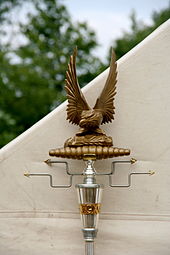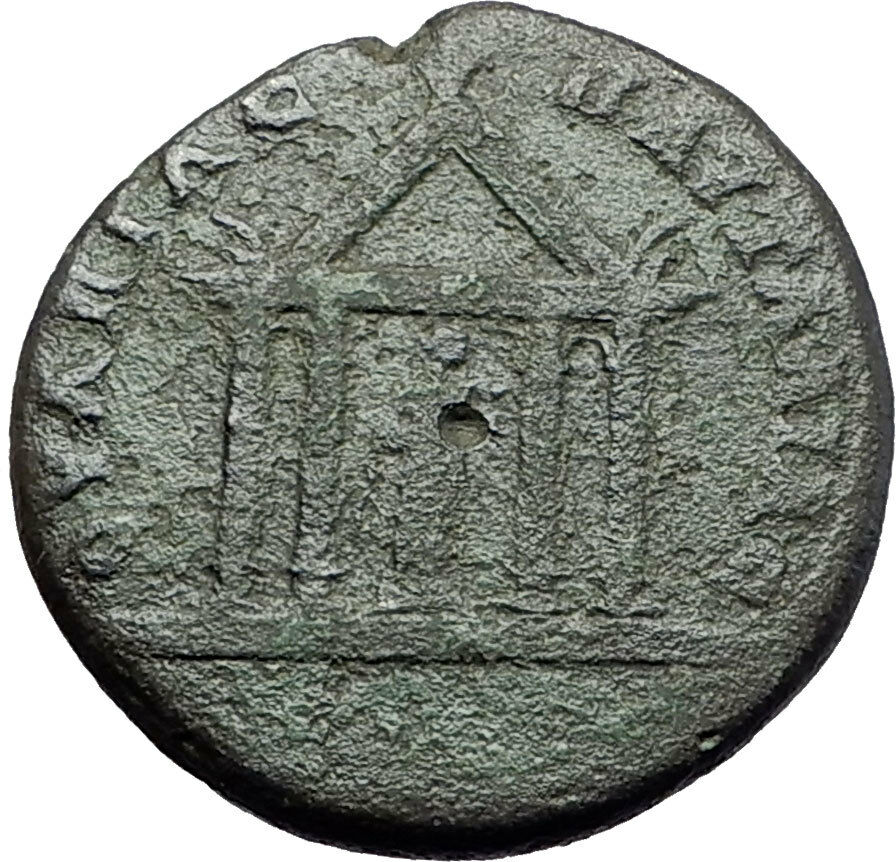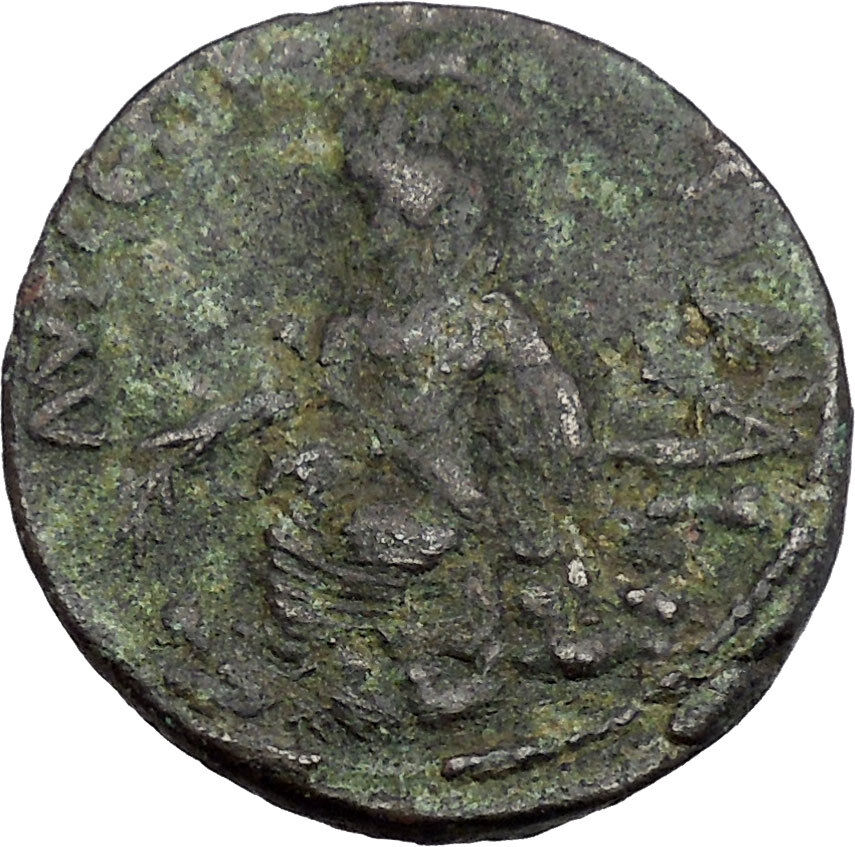|
Gordian III – Roman Emperor: 238-244 A.D. –
Bronze 19mm (3.76 grams) from the Roman provincial city of Nicaea in the
province
of Bythinia 238-244 A.D.
Reference: SNGCop 526, BMC 114, SGI 3671
M ANT ΓOPΔIANOC AV, radiate, draped bust right.
NIKAEΩN, Three legionary standards, centered one tipped with an eagle, the
others
with laurel wreaths.
You are bidding on the exact
item pictured, provided with a Certificate of Authenticity and Lifetime
Guarantee of Authenticity.
An aquila, or eagle, was a prominent symbol used in
ancient Rome, especially as the
standard
of a
Roman legion
. A
legionary
known as an
aquilifer
, or eagle-bearer, carried this
standard. Each legion carried one eagle.

Roman ornament with an aquila (100–200 AD) from the
Cleveland Museum of Art
.
The eagle was extremely important to the Roman military, beyond merely being
a symbol of a legion. A lost standard was considered an extremely grave
occurrence, and the Roman military often went to great lengths to both protect a
standard and to recover it if lost; for example, see the aftermath of the
Battle of the Teutoburg Forest
, where the
Romans spent decades attempting to recover the lost standards of three legions.

A modern reconstruction of an aquila
History
The signa militaria were the Roman military
ensigns
or
standards
. The most ancient standard employed
by the Romans is said to have been a handful (manipulus) of straw fixed
to the top of a spear or pole. Hence the company of soldiers belonging to it was
called a
maniple
. The bundle of
hay
or fern
was soon succeeded by the figures of
animals, of which
Pliny the Elder
(H.N. x.16) enumerates
five: the eagle
, the
wolf
, the ox with the man’s head, the
horse
, and the
boar
. In the second consulship of
Gaius Marius
(104 BC) the four quadrupeds were
laid aside as standards, the eagle (Aquila) alone being retained. It was
made of silver
, or
bronze
, with outstretched wings, but was
probably of a relatively small size, since a standard-bearer (signifer)
under Julius Caesar
is said in circumstances of
danger to have wrenched the eagle from its staff and concealed it in the folds
of his girdle.Under the later emperors the eagle was carried, as it had been for
many centuries, with the legion, a legion being on that account sometimes called
aquila (Hirt. Bell. Hisp. 30). Each
cohort
had for its own ensign the
serpent
or
dragon
, which was woven on a square piece of
cloth textilis anguis, elevated on a
gilt
staff, to which a cross-bar was adapted
for the purpose, and carried by the draconarius.
Another figure used in the standards was a ball (orb), supposed to have been
emblematic of the dominion of Rome over the world; and for the same reason a
bronze figure of
Victoria
was sometimes fixed at the top of the
staff, as we see it sculptured, together with small statues of Mars, on the
Column of Trajan
and the
Arch of Constantine
. Under the eagle or other
emblem was often placed a head of the reigning emperor, which was to the army
the object of idolatrous adoration.[9]
The name of the emperor, or of him who was acknowledged as emperor, was
sometimes inscribed in the same situation. The pole used to carry the eagle had
at its lower extremity an iron point (cuspis) to fix it in the ground, and to
enable the aquilifer in case of need to repel an attack.
The minor divisions of a cohort, called centuries, had also each an ensign,
inscribed with the number both of the cohort and of the century. This, together
with the diversities of the crests worn by the centurions, enabled each soldier
to take his place with ease.

Denarius
minted by
Mark Antony
to pay his legions. On
the reverse, the aquila of his
Third legion
.
In the
Arch of Constantine
at Rome there are four
sculptured panels near the top which exhibit a great number of standards and
illustrate some of the forms here described. The first panel represents Trajan
giving a king to the Parthians: seven standards are held by the soldiers. The
second, containing five standards, represents the performance of the sacrifice
called
suovetaurilia
.
When Constantine embraced Christianity, a figure or emblem of Christ, woven
in gold upon purple cloth, was substituted for the head of the emperor. This
richly ornamented standard was called
labarum
. The labarum is still used today by
the
Orthodox Church
in the Sunday service. The
entry procession of the chalice whose contents will soon become holy communion
is modeled after the procession of the standards of the Roman army.

Eagle and weapons from an
Augustan-era
funerary monument,
probably that of
Messalla
(Prado,
Madrid
)
Even after the adoption of Christianity as the Roman Empire’s religion, the
Aquila eagle continued to be used as a symbol. During the reign of
Eastern Roman Emperor
Isaac I Komnenos
, the single-headed eagle was
modified to
double-headed
to symbolise the Empire’s
dominance over
East and West
.
Since the movements of a body of troops and of every portion of it were
regulated by the standards, all the evolutions, acts, and incidents of the Roman
army were expressed by phrases derived from this circumstance. Thus signa
inferre meant to advance,[15]
referre to retreat, and convertere to face about; efferre,
or castris vellere, to march out of the camp; ad signa convenire,
to re-assemble. Notwithstanding some obscurity in the use of terms, it appears
that, whilst the standard of the legion was properly called aquila, those
of the cohorts were in a special sense of the term called signa, their
bearers being signiferi, and that those of the manipuli or smaller
divisions of the cohort were denominated vexilla, their bearers being
vexillarii. Also, those who fought in the first ranks of the legion before
the standards of the legion and cohorts were called antesignani.
In military stratagems it was sometimes necessary to conceal the standards.
Although the Romans commonly considered it a point of honour to preserve their
standards, in some cases of extreme danger the leader himself threw them among
the ranks of the enemy in order to divert their attention or to animate his own
soldiers. A wounded or dying standard-bearer delivered it, if possible, into the
hands of his general, from whom he had received it signis acceptis.
Lost Aquilae
- Battles where the Aquilae were lost, units that lost the Aquilae and the
fate of the Aquilae:
- 53 BC –
Battle of Carrhae
. Crassus
Legio X
(returned).
- 40 BC – defeat of
Decidius Saxa
at
Cilicia
(returned).
- 36 BC – defeat of
Mark Antony
(returned).
- 19 BC –
Cantabrian Wars
at Hispania.
Legio I Germanica
(thought to have been
lost, and stripped of its title “Augusta”).
- 9 AD –
Battle of the Teutoburg Forest
.
Legio XVII
,
Legio XVIII
, and
Legio XIX
(all recaptured).
- 66 –
Great Jewish Revolt
.
Legio XII Fulminata
(fate uncertain).
- 87 –
Domitian’s Dacian War
.
Legio V Alaudae
(fate uncertain).
- 132 –
Bar Kochva Revolt
.
Legio XXII Deiotariana
(fate
uncertain).
- 161 – Parthians overrun a legion commanded by Severianus at Elegeia
in Armenia, possibly the
Ninth Legion
.[23]
Modern imagery
-
Reconstruction of aquila on Roman vexilloid
-
Aquila clutching fasces, a symbol in Italy during the Fascist
period
-
Aquila on the
coat of arms of Romania
Nicaea
Early history, Roman and Byzantine Empires
The place is said to have been colonized by
Bottiaeans
,
and to have originally borne the name of Ancore (Steph.
B. s. v.) or Helicore (Geogr. Min. p. 40, ed. Hudson); but it was
subsequently destroyed by the
Mysians
. A
few years after the death of
Alexander the Great
,
Macedonian
king
Antigonus
— who had taken control of much of
Asia Minor
upon the death of Alexander (under whom Antigonus had served as a
general) — probably after his victory over
Eumenes
, in
316 BC, rebuilt the town, and called it, after himself, Antigoneia (Greek:
Αντιγόνεια). (Steph. B. l. c.; Eustath. ad
Horn. II. ii. 863) Several other of Alexander’s generals (known together as the
Diadochi
(Latin; original Greek
DiadokhoiΔιάδοχοι/
“successors”)) later conspired to remove Antigonus, and after defeating him the
area was given to
Thessalian
general Lysimachus
(Lysimakhos) (circa 355 BC-281 BC) in 301 BC as his share
of the lands. He renamed it Nicaea (Greek:
Νίκαια
, also
transliterated
as Nikaia or Nicæa; see also
List of traditional Greek place names
), in tribute to his wife Nicaea, a
daughter of Antipater
. (Steph. B., Eustath., Strab., ll. cc.) According to another
account (Memnon, ap. Phot. Cod. 224. p. 233, ed. Bekker), Nicaea was founded by
men from
Nicaea
near
Thermopylae
, who had served in the army of Alexander the Great. The town was
built with great regularity, in the form of a square, measuring 16 stadia in
circumference; it had four gates, and all its streets intersected one another at
right angles, so that from a monument in the centre all the four gates could be
seen. (Strabo
xii. pp. 565 et seq.) This monument stood in the gymnasium, which was
destroyed by fire, but was restored with increased magnificence by the
younger Pliny
(Epist. x. 48), when he was governor of
Bithynia
.
The city was built on an important crossroads between
Galatia
and
Phrygia
, and
thus saw steady trade. Soon after the time of Lysimachus, Nicaea became a city
of great importance, and the kings of Bithynia, whose era begins in 288 BC with
Zipoetes
, often resided at Nicaea. It has already been mentioned that in the
time of Strabo it is called the metropolis of Bithynia, an honour which is also
assigned to it on some coins, though in later times it was enjoyed by
Nicomedia
.
The two cities, in fact, kept up a long and vehement dispute about the
precedence, and the 38th oration of
Dio
Chrysostomus
was expressly composed to settle the dispute. From this
oration, it appears that Nicomedia alone had a right to the title of metropolis,
but both were the first cities of the country.
The younger Pliny makes frequent mention of Nicaea and its public buildings,
which he undertook to restore when governor of Bithynia. (Epist. x. 40, 48,
etc.) It was the birthplace of the astronomer
Hipparchus
(ca. 194 BC), the mathematician and astronomer
Sporus
(ca. 240) and the historian
Dio Cassius
(ca. 165).[1]
It was the death-place of the comedian
Philistion
. The numerous coins of Nicaea which still exist attest the
interest taken in the city by the emperors, as well as its attachment to the
rulers; many of them commemorate great festivals celebrated there in honour of
gods and emperors, as Olympia, Isthmia, Dionysia, Pythia, Commodia, Severia,
Philadelphia, etc. Throughout the imperial period, Nicaea remained an important
town; for its situation was particularly favourable, being only 40 km (25 mi)
distant from Prusa
(Pliny
v. 32), and 70 km (43 mi) from
Constantinople
. (It.
Ant. p. 141.) When Constantinople became the capital of the
Eastern Empire
, Nicaea did not lose in importance; for its present walls,
which were erected during the last period of the Empire, enclose a much greater
space than that ascribed to the place in the time of Strabo. Much of the
existing architecture and defensive works date to this time, early 300s.
Nicaea suffered much from earthquakes in 358, 362 and 368; after the last of
which, it was restored by the emperor
Valens
. During
the Middle Ages it was for a long time a strong bulwark of the
Byzantine
emperors against the
Turks
.
Nicaea
in early Christianity
In the reign of
Constantine
, 325, the celebrated
First Council of Nicaea
was held there against the
Arian
heresy
, and the
prelates there defined more clearly the concept of the
Trinity
and
drew up the
Nicene
Creed
. The doctrine
of the Trinity was finalized at the Council of Constantinople in
381 AD which expressly included the Holy Ghost as equal to the Father and the
Son. The first Nicene Council was probably held in what would become the now
ruined mosque of Orchan. The church of Hagia Sophia was built by
Justinian
I
in the middle of the city in the 6th century (modelled after the larger
Hagia
Sophia
in Constantinople), and it was there that the
Second Council of Nicaea
met in 787 to discuss the issues of
iconography
.
Marcus Antonius Gordianus Pius (January
20, 225
–
February
11
, 244
),
known in
English
as Gordian III,
 was was
Roman
Emperor
from 238 to 244. Gordian was the son of
Antonia Gordiana
and his father was an unnamed Roman Senator who died before
238. Antonia Gordiana was the daughter of Emperor
Gordian I
and younger sister of Emperor
Gordian II
.
Very little is known on his early life before becoming Roman Emperor. Gordian
had assumed the name of his maternal grandfather in 238.
Rise to power
Following the murder of emperor
Alexander Severus
in Moguntiacum (modern
Mainz
), the
capital of the
Roman province
Germania Inferior
,
Maximinus Thrax
was acclaimed emperor, despite strong opposition of the
Roman senate
and the majority of the population. In response to what was
considered in Rome as a rebellion, Gordian’s grandfather and uncle, Gordian I
and II, were proclaimed joint emperors in the
Africa Province
. Their revolt was suppressed within a month by Cappellianus,
governor of Numidia
and a loyal supporter of Maximinus Thrax. The elder Gordians died,
but public opinion cherished their memory as peace loving and literate men,
victims of Maximinus’ oppression.
Meanwhile, Maximinus was on the verge of marching on Rome and
the Senate elected
Pupienus
and Balbinus
as joint emperors. These senators were not popular men and the population of
Rome was still shocked by the elder Gordian’s fate, so that the Senate decided
to take the teenager Gordian, rename him Marcus Antonius Gordianus as his
grandfather, and raise him to the rank of
Caesar
and imperial heir.
Pupienus
and Balbinus
defeated Maximinus, mainly due to the defection of several
legions
,
namely the
Parthica II
who assassinated Maximinus. But their joint reign was
doomed from the start with popular riots, military discontent and even an
enormous fire that consumed Rome in June 238. On
July 29
,
Pupienus and Balbinus were killed by the
Praetorian guard
and Gordian proclaimed sole emperor.
Rule
Due to Gordian’s age, the imperial government was surrendered
to the aristocratic families, who controlled the affairs of Rome through the
senate. In 240,
Sabinianus
revolted in the African province, but the situation was dealt quickly. In 241,
Gordian was married to Furia Sabinia
Tranquillina
, daughter of the newly appointed praetorian prefect,
Timesitheus
. As chief of the Praetorian guard and father in law of the
emperor, Timesitheus quickly became the de facto ruler of the Roman
empire.
In the 3rd century, the Roman frontiers weakened against the
Germanic tribes across the
Rhine
and
Danube
, and the
Sassanid
kingdom across the
Euphrates
increased its own attacks. When the Persians under
Shapur I
invaded Mesopotamia
, the young emperor opened the doors of the
Temple of Janus
for the last time in Roman history, and sent a huge army to
the East. The Sassanids were driven back over the Euphrates and defeated in the
Battle of Resaena
(243). The campaign was a success and Gordian, who had
joined the army, was planning an invasion of the enemy’s territory, when his
father-in-law died in unclear circumstances. Without Timesitheus, the campaign,
and the emperor’s security, were at risk.
Year of the Six Emperors
–
238
|
Maximinus Thrax
|
|
Gordian I
and
Gordian II
|
|
Pupienus
and
Balbinus
, nominally with Gordian
III
|
|
Gordian III
|
|
Marcus Julius Philippus, also known as
Philip the Arab
, stepped in at this moment as the new Praetorian Prefect and
the campaign proceeded. In the beginning of 244, the Persians counter-attacked.
Persian sources claim that a battle was fought (Battle
of Misiche) near modern
Fallujah
(Iraq)
and resulted in a major Roman defeat and the death of Gordian III[1].
Roman sources do not mention this battle and suggest that Gordian died far away,
upstream of the Euphrates. Although ancient sources often described Philip, who
succeeded Gordian as emperor, as having murdered Gordian at Zaitha (Qalat es
Salihiyah), the cause of Gordian’s death is unknown.
Gordian’s youth and good nature, along with the deaths of his
grandfather and uncle and his own tragic fate at the hands of another usurper,
granted him the everlasting esteem of the Romans. Despite the opposition of the
new emperor, Gordian was deified by the Senate after his death, in order to
appease the population and avoid riots.
|












 was
was


